英语八下冀教版unit1lesson1—8辅导学案(功课含解析)
2021年冀教版八年级英语下册Unit 1 Spring Is Coming教学案.doc
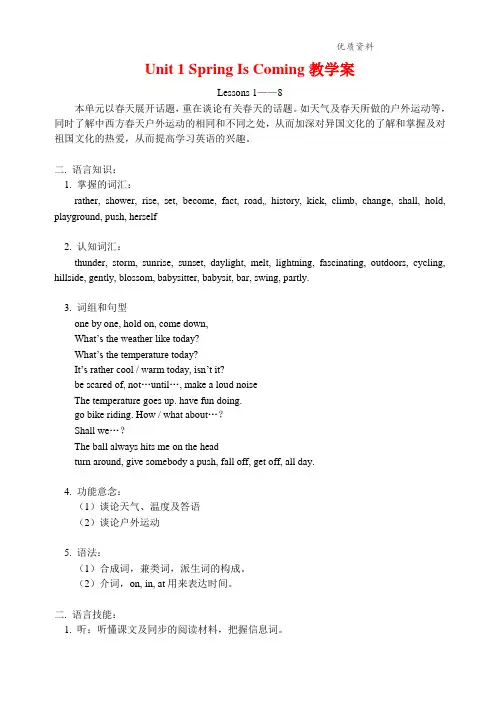
Unit 1 Spring Is Coming教学案Lessons 1——8本单元以春天展开话题,重在谈论有关春天的话题。
如天气及春天所做的户外运动等,同时了解中西方春天户外运动的相同和不同之处,从而加深对异国文化的了解和掌握及对祖国文化的热爱,从而提高学习英语的兴趣。
二. 语言知识:1. 掌握的词汇:rather, shower, rise, set, become, fact, road,history, kick, climb, change, shall, hold, playground, push, herself2. 认知词汇:thunder, storm, sunrise, sunset, daylight, melt, lightning, fascinating, outdoors, cycling, hillside, gently, blossom, babysitter, babysit, bar, swing, partly.3. 词组和句型one by one, hold on, come down,What’s the weather like today?What’s the temperature today?It’s rather cool / warm today, isn’t it?be scared of, not…until…, make a loud noiseThe temperature goes up. have fun doing.go bike riding. How / what about…?Shall we…?The ball always hits me on the headturn around, give somebody a push, fall off, get off, all day.4. 功能意念:(1)谈论天气、温度及答语(2)谈论户外运动5. 语法:(1)合成词,兼类词,派生词的构成。
英语初二下冀教版unit1教案(l1-l8)
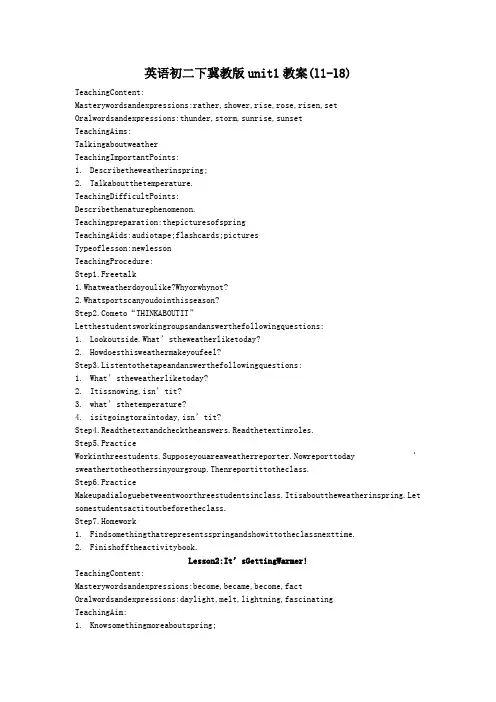
英语初二下冀教版unit1教案(l1-l8)TeachingContent:Masterywordsandexpressions:rather,shower,rise,rose,risen,set Oralwordsandexpressions:thunder,storm,sunrise,sunsetTeachingAims:TalkingaboutweatherTeachingImportantPoints:1.Describetheweatherinspring;2.Talkaboutthetemperature.TeachingDifficultPoints:Describethenaturephenomenon.Teachingpreparation:thepicturesofspringTeachingAids:audiotape;flashcards;picturesTypeoflesson:newlessonTeachingProcedure:Step1.Freetalk1.Whatweatherdoyoulike?Whyorwhynot?2.Whatsportscanyoudointhisseason?eto“THINKABOUTIT”Letthestudentsworkingroupsandanswerthefollowingquestions:1.Lookoutside.What’stheweatherliketoday?2.Howdoesthisweathermakeyoufeel?Step3.Listentothetapeandanswerthefollowingquestions:1.What’stheweatherliketoday?2.Itissnowing,isn’tit?3.what’sthetemperature?4.isitgoingtoraintoday,isn’tit?Step4.Readthetextandchecktheanswers.Readthetextinroles.Step5.PracticeWorkinthreestudents.Supposeyouareaweatherreporter.Nowreporttoday’sweathertotheothersinyourgroup.Thenreportittotheclass.Step6.PracticeMakeupadialoguebetweentwoorthreestudentsinclass.Itisabouttheweatherinspring.Let somestudentsactitoutbeforetheclass.Step7.Homework1.Findsomethingthatrepresentsspringandshowittotheclassnexttime.2.Finishofftheactivitybook.Lesson2:It’sGettingWarmer!TeachingContent:Masterywordsandexpressions:become,became,become,fact Oralwordsandexpressions:daylight,melt,lightning,fascinatingTeachingAim:1.Knowsomethingmoreaboutspring;2.Thecompoundwords.TeachingImportantPoints:1.Whendoesspringbegin?2.HowmanyhoursofdaylightarethereonMarch21st?3.Whatistheweatherlike?TeachingDifficultPoints:thecompoundwordsTeachingPreparation:somepicturesofspringTeachingAids:audiotape,flashcards,somepicturesTypeoflesson:newlessonTeachingProcedure:Step1.Letthestudentsondutyreportstheweathertotheclass.Theotherslistenanddecidei tisrightorwrong.Step2.Listentothetapeandanswerthefollowingquestions:1.What’sthedatetoday?2.Howmanywayscanyouwritedates?3.HowmanyhoursofdaylightarethereonMarch21st?4.Whatisspringweatherlike?5.Whatisthetemperatureoftheairnearlighting?Step3.Readthetextandchecktheanswers.Step4.Listentothetapeagainandimitateafterituntiltheycanreaditfluentlyandcorrect ly.Step5.Askthestudentstoaskotherquestionsaccordingtothetext.Youcanbeginlikethis:1.Whendoesthesunriseinthemorningandwhendoesitsetintheevening?2.Doesitsnowinearlyspring?3.Whatissometimeswiththunderandlighting?eto“LET’SDOIT”.Workingroupsanddiscussthesequestions.Thenletthemreportittotheclass.Step7.Homework1.Finishofftheactivitybook.2.Writeacompositionaboutspring.Summary:Weareenjoyingspringnow.Wecanfeelitiswarmerthanbefore.Butnotallofusknowwhenthesu nrisesinthemorningandsetsintheevening.Letthestudentsobserveafterclass,writeitdo wnandreportittotheclass.Itcancultivatethestudents’interestsoflearningEnglish.Lesson3:Postcards!TeachingContent:Masterywordsandexpressions:roadOralwordsandexpressions:outdoorsTeachingAim:1.Grasphowtowritealetterandtheaddress.2.KnowmoreaboutthespringinChinaandCanada.TeachingImportantPoints:1.FindthedifferencesbetweenChinaandCanadainspring.3.Findthedifferencesbetweentheclothesthatwewearinwinterandinspring. TeachingDifficultPoints:1.What’stheweatherlikeinEdmonton?2.Howtoexpressone’sideaeasilyinaletter?TeachingPreparation:apostcardTeachingAids:audiotape,flashcards,postcardsTypeoflesson:newlessonTeachingProcedure:Step1.FreeTalk Letthestudentsworkinthreeandtalkaboutthesportsthatweoftendoinspring.Thengiveata lkfortheclass.Step2.HaveamatchReadthetextandseewhoreaditbest.Remembertoencouragethestudentswhopreviewthenewle sson.Step3.Listentothetapeandreadafterit.Playthetapeforseveraltimesuntiltheycanreadi tfluentlyandcorrectly.Step4.Askthestudentstofindquestionsandsolvethem.Theycanaskthequestionslikethis:1.HowdidLiMinggotoschoolonMarchtwenty-first?2.What’sthetemperaturethatafternoon?3.Whattimedoesthesunrisethismorning?4.IsitsnowinginCanada?5.Whendoesitoftensnowinwinter?6.DidDannyfallinthesnow?eto“THINKABOUTIT”Writeapostcardtoyourfriendtointroducetheweatherhere.Thenwritetheaddressandstick astamponit.Mailitinthepostoffice.Step6.Homework1.Finishofftheactivitybook.2.ListentothesonginLesson4.Summary: WrittenEnglishisanimportantpartinEnglishlearning.Practiceisthekeytoit.Dotheyhav ethespellingmistakesorthegrammarmistakesinthewriting?Findoutandhelpthemcomeover it.Paymoreattentiontothewritingbecauseit’sanimportantpartofcommunication.Lesson4:SunIsRisingTeachingContent:Masterywordsandexpressions:onebyone,changeOralwordsandexpressions:hillside,gently,blossomTeachingAim:EnjoythebeautyofthespringTeachingImportantPoint:GraspthechangesthatspringbringusTeachingDifficultPoints:Howtouse“warm”and“gently”.TeachingPreparation:somethingthatrepresentsspringTeachingAids:audiotape,flashcards,picturesorflowersTypeoflesson:newlessonTeachingProcedure:Step1.Readthesongaloudasapoem.ThissonghasthissonghascommonEnglishwords:comewith me,throughthetrees,onebyone,theflowersblossom.TranslatetheseexpressionsintoEngl ish.Step2.Playtheaudiotapeandletthestudentsjustlistenwiththeeyeclosed.Step3.Playthetapeagainandletthestudentssingwithit.Step4.ExplainthecommonEnglishexpressions.Step5.Practicethesongafewtimes,withandwithouttheaudiotape.eto“LET’SDOIT”.STEP7.Homework1.Finishofftheactivitybook.2.Writedownwhatyoucanseeinspring.Summary Weusethislessontocultivatethestudents’senseofenjoyingEnglishsongs.Payattentiontotherhyme,rhythmandrepetitioninthesong .LearningEnglishsongsisalittledifficultfromChinesesongs.Findthewaysinwhichwecan learnfast.Lesson5:FunintheSunTeachingContent:Masterywordsandexpressions:shall,kickOralwordsandexpressions:cycling,How/Whatabout…?Shallwe…?TeachingAims:Howtoenjoyoneselfinspring.TeachingImportantPoints:1.thesportsthatwedoinspring.2.somedrills:Howabout…?Let’s…TeachingDifficultPoints:Howtoadvicesb.todosth.TeachingPreparation:basketballandsoccerTeachingAids:audiotape,flashcardsandballsTypeoflesson:newlessonTeachingProcedure:Step1.ListentothetapeofLesson4again,thenlet’ssingthesongtogether.Step2.Listentothetapeandanswerthefollowingquestions:1.What’sthedegree?2.WhatwillDannyweartomorrow?3.Whatwilltheydoafterschool?4.Whydon’tDannylikebasketball?Step3.Readthetextandchecktheanswers.Thenreadthetextagain.Step4.Actthedialogueoutinfrontoftheclass.Step5.Makeupasimilardialogueaccordingtothetext.Let’sthestudentsactitoutinfrontoftheclass.eto“PROJECT”.Dividetheclassintoseveralgroups.Writetheanswersdown.Asktheseveralgroupstochange theiranswers.Step7.Homework1.Finishofftheactivitybook.2.Reviewthelastlesson.SummarySpringisabeautifulseason.It’sthefavouriteseasonofmanypeople.Inthisseason,everythingbeginstoturngreen.Spring representsthebeginning.Wehavemanythingstodoinit.Wecanflykitesandplayballgames.R unninginthewindiswhatweliketodoinourchildhood.Leadyourstudentstothinkhardwhatth eyliketodointhisseason.Letthemtalkfreelyintheclass.Lesson6.DannythebabysitterTeachingContent:Masterywordsandexpressions:playground,hold,holdon,comedown,push Oralwordsandexpressions:babysitter,babysit,Debbie,bar,swing,swung TeachingAims:1.Weshouldloveeachother.2.ThedutyofababysitterTeachingImportantPoints:1.Howtodemonstrateonethingclearly.3.Cultivatethespiritoflovingeachother.Let’slovelifeandpeace. TeachingDifficultPoints:Someverbphrases:turnaround,holdon,falloff,runto,comedown,climbon,givesb.apush TeachingAids:audiotape,flashcards,picturesTypeoflesson:newlessonTeachingProcedure:Step1.Workinpairs.Tellyourpartnerwhatyoudidafterschoolyesterday.Theteacherwalks aroundtoprovidehelpifnecessary.Step2.Skimthetextandaskquestionsbythestudentsthemselves.Thensolvethembythemselv es,too.Letsomestudentswritetheirquestionsontheblackboard.Thenletothersanswerthe m.Step3.Listentothetapeandreadafterituntiltheycanreaditcorrectlyandfluently.Step4.Asksomestudentstocometothefrontandactitout.Payattentiontowhoiscleverenoug htoaddsomethingnew.Step5.Retellthestoryinathirdperson.eto“THINKABOUTIT”.Inagroupofthree,makeupa“babysitting”role-play.Askvolunteerstoactitout.Thenit’stheotherstudents’turn.Step7.Homework1.Finishofftheactivitybook.2.supposeoneday,youbecomeababysitter,whatwillyoudo?SummaryWhenwepracticeintheclass,don’tforgettogivechancestothepoorstudents.Whentheyhavealittleprogress,encouragethem toworkhard.That’swhatagoodteachershoulddo.Lesson7:Danny’s“Debbie”DayTeachingContent:Masterywordsandexpressions:herselfOralwordsandexpressions:partly,alldayTeachingAims:1.Learntowriteadiary.2.Whatdowewriteinadiary.TeachingImportantPoints:Whenwearebabysitters,whatcanwedo?TeachingDifficultPoints:thePastTenseTeachingPreparation:sometoysTeachingAids:audiotape,flashcards,sometoysTypeoflesson:newlessonTeachingProcedure:Step1.Workingroups.RetellLesson6inPastTenseinathirdperson.Step2.Readthetextsilentlybystudentsthemselves.Thenanswerthequestionsintheactivi ty.Checktheanswersintheclass.Step3.Listentothetapeandreadafterit.Somestudentsmaythinkitiseasytolistenwiththe book.Thenlistentothetapeagainwiththebookclosed.Atthesametime,theteacheraskssome studentstorepeatsomesentencestoseeiftheycanlistenclearly.Step4.Letsomestudentsreadthetextaloudinfrontoftheclass.Let’shaveamatch.Whocanreaditfastandcorrectly?Step5.PracticeWorkingroups.Writedownexperiencethatyouhaveeverbeenababysitter.Doyouthinkiteasy tobeababysitter?Whyorwhynot?eto“LET’SDOIT”.Step7.Homework1.Finishofftheactivitybook.2.DotheexercisesonPage9.SummaryCanyouwritedownyourexperienceclearly?Weoftenwriteinatimeorder.Expressingyouride asinEnglishisnoteasy.Sogivethestudentsmorechancetopractice.Writingisalsoanimportantwaytocheckthegrammars.Lesson8:UnitReviewTeachingContent:MasterywordsandexpressionsfromLesson1toLesson8. OralwordsandexpressionsfromLesson1toLesson8.TeachingAims:1.Knowaboutmoreknowledgeinspring.Therearemanythingsthatwedon’tknowbefore.2.WhatsportsdopeopleusuallydoinChinaandinCanada?TeachingImportantPoints:1.What’stheweatherlikeinspring?2.Thesportsthatwedoinspring.TeachingDifficultPoints:Theusingofsomeexpressions:Let’s…,shallwe…?turnaround,comedown,finally,then TeachingPreparation:picturesTeachingAids:audiotape,flashcards,picturesTeachingProcedure:Step1.Firstlet’ssingthesongtogether.Step2.TalkwithyourpartnersaboutthedifferencesbetweenthesportsthatwedoinChinaand inCanada.Step3.Haveyoueverbeenababysitter?Letsomestudentstalkabouttheirexperienceinfront oftheclass.Step4.FinishtheexercisesonPage7.Findsomedifficultiesandsolvetheminfrontofthecla ss.Step5.Letsomestudentstalkaboutwhatwelearninthisunit.Whatdotheywanttosayaboutspr ing?Step6.Homework1.Finishofftheexercisesinactivity.2.Prepareforasmallquiz.SummaryTheaimofteachingisnotwhattheylearn.Themostimportantistoteachthemhowtolearn.Cult ivatetheabilityoflearningbythemselvesintheclass.Encouragethemtofindandsolveques tionsinclass.。
八年级英语下册 Unit1 lesson1教案 冀教版
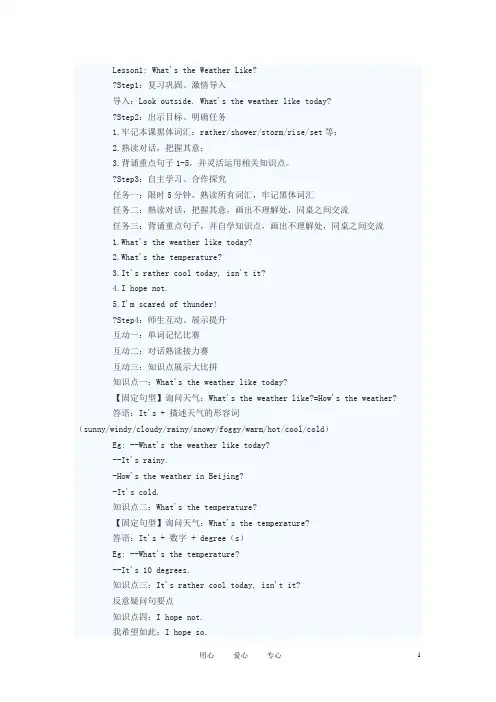
Lesson1: What's the Weather Like??Step1:复习巩固、激情导入导入:Look outside. What's the weather like today??Step2:出示目标、明确任务1.牢记本课黑体词汇:rather/shower/storm/rise/set等;2.熟读对话,把握其意;3.背诵重点句子1-5,并灵活运用相关知识点。
?Step3:自主学习、合作探究任务一:限时5分钟,熟读所有词汇,牢记黑体词汇任务二:熟读对话,把握其意,画出不理解处,同桌之间交流任务三:背诵重点句子,并自学知识点,画出不理解处,同桌之间交流1.What's the weather like today?2.What's the temperature?3.It's rather cool today, isn't it?4.I hope not.5.I'm scared of thunder!?Step4:师生互动、展示提升互动一:单词记忆比赛互动二:对话熟读接力赛互动三:知识点展示大比拼知识点一:What's the weather like today?【固定句型】询问天气:What's the weather like?=How's the weather?答语:It's + 描述天气的形容词(sunny/windy/cloudy/rainy/snowy/foggy/warm/hot/cool/cold)Eg: --What's the weather like today?--It's rainy.-How's the weather in Beijing?-It's cold.知识点二:What's the temperature?【固定句型】询问天气:What's the temperature?答语:It's + 数字 + degree(s)Eg: --What's the temperature?--It's 10 degrees.知识点三:It's rather cool today, isn't it?反意疑问句要点知识点四:I hope not.我希望如此:I hope so.我不希望如此:I hope not.不说 I don't hope so. 【类似表达】I'm afraid so./I'm afraid not,I think so. /I don't think so.知识点五:I'm scared of thunder!be scared/afraid of sb/sth恐惧某人或某物(其中用scared比用afraid“害怕”的程度更深)Eg: Are you scared of snakes??Step5:巩固练习、检测验收教学反思:。
冀教版八年级英语下册《Unit-1-Spring-Is-Coming-》教案.docx
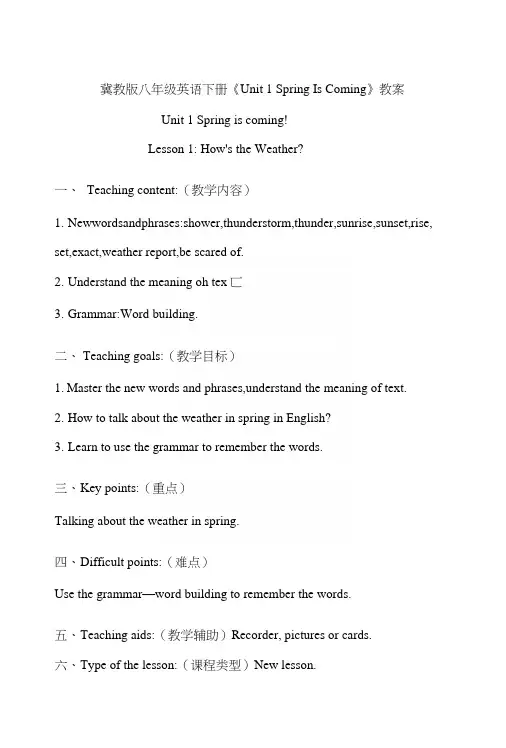
冀教版八年级英语下册《Unit 1 Spring Is Coming》教案Unit 1 Spring is coming!Lesson 1: How's the Weather?一、Teaching content:(教学内容)1.Newwordsandphrases:shower,thunderstorm,thunder,sunrise,sunset,rise, set,exact,weather report,be scared of.2.Understand the meaning oh tex匸3.Grammar:Word building.二、Teaching goals:(教学目标)1.Master the new words and phrases,understand the meaning of text.2.How to talk about the weather in spring in English?3.Learn to use the grammar to remember the words.三、K ey points:(重点)Talking about the weather in spring.四、D ifficult points:(难点)Use the grammar—word building to remember the words.五、T eaching aids:(教学辅助)Recorder, pictures or cards.六、T ype of the lesson:(课程类型)New lesson.七、T eaching procedure:(教学过程)Step 1 .Analysis of the student.(学生分析)Greet the students in English and make sure they can response correctly.Do the duty report: a student on duty can say whatever he/she likes to say. Review:Now we are at the beginning of the school,new term is coming and spring is st term,we learned how to talk our hobby and our future,we learned transportation,we learned neighborhood,and now what will we learn?Step 2. Lead in.(引入)Ask some Ss to introduce the weather in Wuhan ?T:Whafs the weather like today?S:Its sunny/windy/cloudy .........Come to “Think About It!"How is the weather in your hometown in spring?Have you ever heard a weather report?What expressions do they often use? Step 3. New lesson.(新课)No. 1 prepare lessons before class.Teach the new words and phrases.make sure the Ss can read it correctly・No. 2 Text:Give them some time to read the text themselves・ Then let them act out the dialogue in groups・ Correct their pronunciation when necessary.At last,the teacher explain the text in Chinese,make sure the Ss can understand the meaning of text.No. 3Important sentences:1 .How is the weather? It's sunny/windy/cloudy ...........2.What's the weather like today?3.What's the temperature? The temperature is ........4.Fm scared of thunder. (be scared of)No. 4 Gammar:Word building・Eg: thunderstorm,sunrise,sunset,hometown,basketball.英语构词法主要有三种:合成法、转化法和派生法。
英语八年级下册冀教版unit1教案(l1-l8)
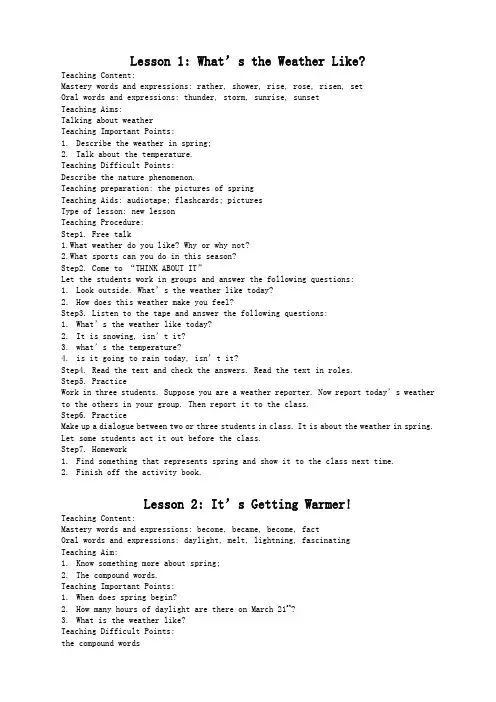
Lesson 1: What’s the Weather Like?Teaching Content:Mastery words and expressions: rather, shower, rise, rose, risen, setOral words and expressions: thunder, storm, sunrise, sunsetTeaching Aims:Talking about weatherTeaching Important Points:1.Describe the weather in spring;2.Talk about the temperature.Teaching Difficult Points:Describe the nature phenomenon.Teaching preparation: the pictures of springTeaching Aids: audiotape; flashcards; picturesType of lesson: new lessonTeaching Procedure:Step1. Free talk1.What weather do you like? Why or why not?2.What sports can you do in this season?Step2. Come to “THINK ABOUT IT”Let the students work in groups and answer the following questions:1.Look outside. What’s the weather like today?2.How does this weather make you feel?Step3. Listen to the tape and answer the following questions:1.What’s the weather like today?2.It is snowing, isn’t it?3.what’s the temperature?4.is it going to rain today, isn’t it?Step4. Read the text and check the answers. Read the text in roles.Step5. PracticeWork in three students. Suppose you are a weather reporter. Now report today’s weather to the others in your group. Then report it to the class.Step6. PracticeMake up a dialogue between two or three students in class. It is about the weather in spring. Let some students act it out before the class.Step7. Homework1.Find something that represents spring and show it to the class next time.2.Finish off the activity book.Lesson 2: It’s Getting Warmer!Teaching Content:Mastery words and expressions: become, became, become, factOral words and expressions: daylight, melt, lightning, fascinatingTeaching Aim:1.Know something more about spring;2.The compound words.Teaching Important Points:1.When does spring begin?2.How many hours of daylight are there on March 21st?3.What is the weather like?Teaching Difficult Points:the compound wordsTeaching Preparation: some pictures of springTeaching Aids: audiotape, flashcards, some picturesType of lesson: new lessonTeaching Procedure:Step1. Let the students on duty reports the weather to the class. The others listen and decide it is right or wrong.Step2. Listen to the tape and answer the following questions:1.What’s the date today?2.How many ways can you write dates?3.How many hours of daylight are there on March 21st?4.What is spring weather like?5.What is the temperature of the air near lighting?Step3. Read the text and check the answers.Step4. Listen to the tape again and imitate after it until they can read it fluently and correctly.Step5. Ask the students to ask other questions according to the text. You can begin like this:1.When does the sun rise in the morning and when does it set in the evening?2.Does it snow in early spring?3.What is sometimes with thunder and lighting?Step6. Come to “LET’S DO IT”.Work in groups and discuss these questions. Then let them report it to the class. Step7. Homework1.Finish off the activity book.2.Write a composition about spring.Summary:We are enjoying spring now. We can feel it is warmer than before. But not all of us know when the sun rises in the morning and sets in the evening. Let the students observe after class, write it down and report it to the class. It can cultivate the students’interests of learning English.Lesson 3: Postcards!Teaching Content:Mastery words and expressions: roadOral words and expressions: outdoorsTeaching Aim:1.Grasp how to write a letter and the address.2.Know more about the spring in China and Canada.Teaching Important Points:1. Find the differences between China and Canada in spring.3.Find the differences between the clothes that we wear in winter and in spring. Teaching Difficult Points:1.What’s the weather like in Edmonton?2.How to express one’s idea easily in a letter?Teaching Preparation: a postcardTeaching Aids: audiotape, flashcards, postcardsType of lesson: new lessonTeaching Procedure:Step1. Free TalkLet the students work in three and talk about the sports that we often do in spring. Then give a talk for the class.Step2. Have a matchRead the text and see who read it best. Remember to encourage the students who preview the new lesson.Step3. Listen to the tape and read after it. Play the tape for several times until they can read it fluently and correctly.Step4. Ask the students to find questions and solve them. They can ask the questions like this:1.How did Li Ming go to school on March twenty-first?2.What’s the temperature that afternoon?3.What time does the sun rise this morning?4.Is it snowing in Canada?5.When does it often snow in winter?6.Did Danny fall in the snow?Step5. Come to “THINK ABOUT IT”Write a postcard to your friend to introduce the weather here. Then write the address and stick a stamp on it. Mail it in the post office.Step6. Homework1.Finish off the activity book.2.Listen to the song in Lesson 4.Summary:Written English is an important part in English learning. Practice is the key to it. Do they have the spelling mistakes or the grammar mistakes in the writing? Find out and help them come over it. Pay more attention to the writing because it’s an important part of communication.Lesson 4: Sun Is RisingTeaching Content:Mastery words and expressions: one by one, changeOral words and expressions: hillside, gently, blossomTeaching Aim:Enjoy the beauty of the springTeaching Important Point:Grasp the changes that spring bring usTeaching Difficult Points:How to use “warm” and “gently”.Teaching Preparation: something that represents springTeaching Aids: audiotape, flashcards, pictures or flowersType of lesson: new lessonTeaching Procedure:Step1. Read the song aloud as a poem. This song has this song has common English words: come with me, through the trees, one by one, the flowers blossom. Translate these expressions into English.Step2. Play the audiotape and let the students just listen with the eye closed.Step3. Play the tape again and let the students sing with it.Step4. Explain the common English expressions.Step5. Practice the song a few times, with and without the audiotape.Step6. Come to “LET’S DO IT”.STEP7. Homework1.Finish off the activity book.2.Write down what you can see in spring.SummaryWe use this lesson to cultivate the students’ sense of enjoying English songs. Pay attention to the rhyme, rhythm and repetition in the song. Learning English songs is a little difficult from Chinese songs. Find the ways in which we can learn fast.Lesson 5: Fun in the SunTeaching Content:Mastery words and expressions: shall, kickOral words and expressions: cycling, How/What about…? Shall we…?Teaching Aims:How to enjoy oneself in spring.Teaching Important Points:1. the sports that we do in spring.2.some drills: How about…? Let’s…Teaching Difficult Points:How to advice sb. to do sth.Teaching Preparation: basketball and soccerTeaching Aids: audiotape, flashcards and ballsType of lesson: new lessonTeaching Procedure:Step1. Listen to the tape of Lesson4 again, then let’s sing the song together.Step2. Listen to the tape and answer the following questions:1.What’s the degree?2.What will Danny wear tomorrow?3.What will they do after school?4.Why don’t Danny like basketball?Step3. Read the text and check the answers. Then read the text again.Step4. Act the dialogue out in front of the class.Step5. Make up a similar dialogue according to the text. Let’s the students act it outin front of the class.Step6. Come to “PROJECT”.Divide the class into several groups. Write the answers down. Ask the several groups to change their answers.Step7. Homework1.Finish off the activity book.2.Review the last lesson.SummarySpring is a beautiful season. It’s the favourite season of many people. In this season, everything begins to turn green. Spring represents the beginning. We have many things to do in it. We can fly kites and play ball games. Running in the wind is what we like to do in our childhood. Lead your students to think hard what they like to do in this season. Let them talk freely in the class.Lesson 6. Danny the babysitterTeaching Content:Mastery words and expressions: playground, hold, hold on, come down, pushOral words and expressions: babysitter, babysit, Debbie, bar, swing, swungTeaching Aims:1.We should love each other.2.The duty of a babysitterTeaching Important Points:1.How to demonstrate one thing clearly.3.Cultivate the spirit of loving each other. Let’s love life and peace.Teaching Difficult Points:Some verb phrases: turn around, hold on, fall off, run to, come down, climb on, give sb.a pushTeaching Aids: audiotape, flashcards, picturesType of lesson: new lessonTeaching Procedure:Step1. Work in pairs. Tell your partner what you did after school yesterday. The teacher walks around to provide help if necessary.Step2. Skim the text and ask questions by the students themselves. Then solve them by themselves, too. Let some students write their questions on the blackboard. Then let others answer them.Step3. Listen to the tape and read after it until they can read it correctly and fluently. Step4. Ask some students to come to the front and act it out. Pay attention to who is clever enough to add something new.Step5. Retell the story in a third person.Step6. Come to “THINK ABOUT IT”.In a group of three, make up a “babysitting” role-play. Ask volunteers to act it out. Then it’s the other students’ turn.Step7. Homework1.Finish off the activity book.2.suppose one day, you become a babysitter, what will you do?SummaryWhen we practice in the class, don’t forget to give chances to the poor students. When they have a little progress, encourage them to work hard. That’s what a good teacher should do.Lesson 7: Danny’s “Debbie” DayTeaching Content:Mastery words and expressions: herselfOral words and expressions: partly, all dayTeaching Aims:1.Learn to write a diary.2.What do we write in a diary.Teaching Important Points:When we are babysitters, what can we do?Teaching Difficult Points: the Past TenseTeaching Preparation: some toysTeaching Aids: audiotape, flashcards, some toysType of lesson: new lessonTeaching Procedure:Step1. Work in groups. Retell Lesson 6 in Past Tense in a third person.Step2. Read the text silently by students themselves. Then answer the questions in the activity. Check the answers in the class.Step3. Listen to the tape and read after it. Some students may think it is easy to listen with the book. Then listen to the tape again with the book closed. At the same time, the teacher asks some students to repeat some sentences to see if they can listen clearly. Step4. Let some students read the text aloud in front of the class. Let’s have a match. Who can read it fast and correctly?Step5. PracticeWork in groups. Write down experience that you have ever been a babysitter. Do you think it easy to be a babysitter? Why or why not?Step6. Come to “LET’S DO IT”.Step7. Homework1.Finish off the activity book.2.Do the exercises on Page 9.SummaryCan you write down your experience clearly? We often write in a time order. Expressing your ideas in English is not easy. So give the students more chance to practice. Writing is also an important way to check the grammars.Lesson 8: Unit ReviewTeaching Content:Mastery words and expressions from Lesson1 to Lesson8.Oral words and expressions from Lesson1 to Lesson8.Teaching Aims:1.Know about more knowledge in spring. There are many things that we don’tknow before.2.What sports do people usually do in China and in Canada?Teaching Important Points:1.What’s the weather like in spring?2.The sports that we do in spring.Teaching Difficult Points:The using of some expressions: Let’s…, shall we…?turn around, come down, finally, thenTeaching Preparation: picturesTeaching Aids: audiotape, flashcards, picturesTeaching Procedure:Step1. First let’s sing the song together.Step2. Talk with your partners about the differences between the sports that we do in China and in Canada.Step3. Have you ever been a babysitter? Let some students talk about their experience in front of the class.Step4. Finish the exercises on Page7. Find some difficulties and solve them in front of the class.Step5.Let some students talk about what we learn in this unit. What do they want to say about spring?Step6. Homework1.Finish off the exercises in activity.2.Prepare for a small quiz.SummaryThe aim of teaching is not what they learn. The most important is to teach them how to learn. Cultivate the ability of learning by themselves in the class. Encourage them to find and solve questions in class.。
冀教版英语八下Unit 1《Lesson 1 Hows the weather》教学设计
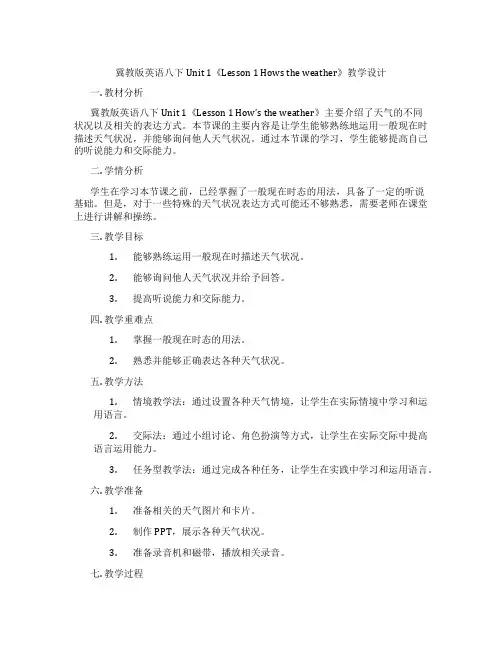
冀教版英语八下Unit 1《Lesson 1 Hows the weather》教学设计一. 教材分析冀教版英语八下Unit 1《Lesson 1 How’s the weather》主要介绍了天气的不同状况以及相关的表达方式。
本节课的主要内容是让学生能够熟练地运用一般现在时描述天气状况,并能够询问他人天气状况。
通过本节课的学习,学生能够提高自己的听说能力和交际能力。
二. 学情分析学生在学习本节课之前,已经掌握了一般现在时态的用法,具备了一定的听说基础。
但是,对于一些特殊的天气状况表达方式可能还不够熟悉,需要老师在课堂上进行讲解和操练。
三. 教学目标1.能够熟练运用一般现在时描述天气状况。
2.能够询问他人天气状况并给予回答。
3.提高听说能力和交际能力。
四. 教学重难点1.掌握一般现在时态的用法。
2.熟悉并能够正确表达各种天气状况。
五. 教学方法1.情境教学法:通过设置各种天气情境,让学生在实际情境中学习和运用语言。
2.交际法:通过小组讨论、角色扮演等方式,让学生在实际交际中提高语言运用能力。
3.任务型教学法:通过完成各种任务,让学生在实践中学习和运用语言。
六. 教学准备1.准备相关的天气图片和卡片。
2.制作PPT,展示各种天气状况。
3.准备录音机和磁带,播放相关录音。
七. 教学过程1.导入(5分钟)通过播放一段天气预报的录音,引导学生关注天气主题。
然后向学生提问:“What’s the weather like today?”,让学生回答。
2.呈现(10分钟)向学生展示各种天气图片和卡片,如sunny, cloudy, rny, windy等,并引导学生用英语描述这些天气状况。
同时,让学生注意一般现在时的用法。
3.操练(10分钟)让学生进行小组讨论,用英语描述自己喜欢的天气状况,并询问组员们的天气喜好。
教师巡回指导,纠正发音和语法错误。
4.巩固(10分钟)让学生观看一段关于不同天气状况的视频,并填写一份天气状况调查表。
全新冀教版八年级英语下册教案(全册 共114页)
全新冀教版八年级英语下册教案(全册共114页)目录Unit 1 Spring is coming! Array Lesson 1 How’s t he weather?Lesson 2 It’s getting warmer!Lesson 3 The sun is rising!Lesson 4 The Spring CityLesson 5 Babysitting on a Spring DayLesson 6 Stories about springUnit 2 Plant a PlantLesson 7 Planting treesLesson 8 Why are plants important?Lesson 9 Gardening with MaryLesson 10 Make your garden grow!Lesson 11 Amazing plantsLesson 12 Danny’s plantUnit 3 Animals are our friendsLesson 13 Danny’s big scareLesson 14 Amazing animalsLesson 15 The zoo is openLesson 16 The Bear EscapedLesson 17 Save the tigersLesson 18 Friendship between animalsUnit 4 The Internet Connects UsLesson 19 How Do You Use the Internet?Lesson 20 A computer helpsLesson 21 Books or computers?Lesson 22 Travel on the InternetLesson 23 The Internet-Good or Bad?Lesson 24 An Email to GrandpaUnit 5 Buying and SellingLesson 25: Raising MoneyLesson 26 Cookies, Please!Lesson 27 Business EnglishLesson 28 Ms. Liu’s Great IdeaUnit 1 Spring is coming!Lesson 1 How’s the weather?◆教材分析本节课是冀教版初中英语八年级下册第一单元lesson1,功能话题是谈论天气;文本结构是对话;语法重点是初步认识合成词,并能够运用将来时态预测天气,以及正确使用will写简短的天气预报。
冀教版英语八年级下册Unit 1:Lesson 1 How‘s The Weather?. 学案设计
1.shower n 阵雨,淋浴 v 下阵雨 【点拨】Take a shower 意为“淋浴”
1) He always
a shower before he goes to bed.
2) The little boy is
a shower now.
A take B do C taking D doing
?
---It’s sunny.
What’s the temperature
How is the weather like today
What day is it today
What’s the weather like today What’s the temperature? 气温是多少度? 点拨:用来询问温度时的常用语,回答时用:It’s + 数词+degrees.
The book is rather long. 这本书有点长。(用于形容词和副词前)
This hotel is rather cheaper than that one. 这家旅馆比那家便宜得
5. I hope not! 我希望不是这样。
点拨:习惯上不说:I don’t hope so. 它的肯定表达方式为:I hope so.
(rise) in the east.
点拨:此词组后跟 n ,代词,动名词,与 be afraid of 意思相近,但 be scared of 比 be afraid of 所表达的“害怕”程度更深。
Ⅱ. 能读懂文章并尝试背诵
学习指导:what’s the weather like today? 今天天气怎么样?
( ) ---What’s the temperature today?
八年级英语下册Lesson1教材内容详解冀教版
八年级,英语,下册,Lesson1,教材,内容,详解,冀,教材内容全解Lesson 1 What’s the Weather Like?天气怎么样?◆课文英汉对照THINK ABOUT IT! 想一想!● Look outside. What’s the weather like today?看外面。
今天的天气怎么样?● How does this weather make you feel?这样的天气使你感觉怎么样?● Is Danny a go od weather reporter? Why or why not?丹尼是一个好的天气报告员吗?为什么是或为什么不是?A Weather Report 天气预报DANNY: Listen to me! I’m on the radio!丹尼:注意听!我正在播报!JENNY:(She laughs)Danny! When it snows, it isn’t hot. It’s cold!詹妮:(她笑了)丹尼!下雪的时候,天不热,很冷!DANNY: Okay, it’s not hot. It’s not snowing, and there are some clouds. 丹尼:对,天不热。
天没有下雪。
有一些云。
JENNY: What’s the temperature?詹妮:气温是多少?DANNY: Let's see. It’s ten degrees.丹尼:让我们看一下,是10度。
BRIAN: It’s rather cool today, isn’tit? Is it going to rain today, Danny?布莱恩:今天天气很凉爽,是吧?丹尼,今天要下雨吗?DANNY: Yes! There will be some showers this afternoon. Maybe there will be a thunder storm. I hope not! I’m scared of thunder!丹尼:对!今天下午将有阵雨,也许有雷阵雨。
冀教版八年级英语下册1-8单元教案
Unit 1 Spring Is ComingFunctions:Talking about weather.What’s the weather like today?It’s rather cold/warm today, isn’t?It’s sunny/rainy/snowy/windy/warm/hot/cold/cool.It’s a nice day today!What a cold day!It’s getting warm.Grammar:Word building: sun + rise = ___Prepositions: on, in, atStructures: fall off, How /What about…?make a loud noise, not…until…Shall…we…?Lesson 1 What’s the weather like?Learning aims:1. The words and phrases: rather, shower, rise, set, thunder, storm, sunrise, sunset, be scared of2. The important sentences:①What’s the temperature? It’s ten degrees.②It’s rather cool today, isn’t it?③I’m scared of thunder.Learning important and difficult points:1. What’s the weather like today? It’s cold, cool, warm.2. What’s the temperature? It’s ten degrees.3. be scared of sb./sth.4. There will be… = There is/are going to be …Learning method:Listen, say, read and write.Learning steps:Step 1. TalkingTalk about the weather, the weather report and the temperature.Step 2. ReadingRead the dialogue, and then answer the question.What’s the temperature?Step 3. ExplainingExplain 1. 一般将来时be going to do sth. = will do sth.2. 询问温度是多少要用: What’s the temperature?Step 4. PracticePractice the dialogue in three.Step 5. Act outAct it out in class.Step 6. Do exercisesStep 7. HomeworkLesson 2 It’s getting warmer!Learning aims:1. The new words and language points: become, fact, daylight, melt, lightning, fascinating, go up, make a loud noise2. The important sentences:①What’s the date today? It’s March twenty-first.② In Spring, the weather becomes warmer.③ The temperatures goes up.Learning important and difficult points:Ask and describe the weather of spring.1. What is spring weather like?2. It becomes warmer. The temperature goes up! Learning method:Listen, say, read and write.Learning steps:Step 1. CheckCheck Lesson 1: ask some students to act the dialogue out. Step 2. LearningLearn the new words. Read and write.Step 3. LookingLook at the pictures and read it.Step 4. LearningLearn it. Find out the useful expressions.Step 5. PracticePractice the dialogue.Step 6. ExercisesStep 7. Homework: Describe spring.教后反思:Lesson 3 Postcard Learning aims:1. The words and phrases: road, outdoors, cycling2. The important sentences:① Spring has arrived in Shijiazhuang.② I see many people in the park exercising.③We won’t see any flowers until May.④ The sun will set in about fifteen minutes.Learning important and difficult points:1. 区分arrive 与reach2. not…until… “直到……才”They didn’t leave until they finished the work.Learning method:Listen, say, read and write.Learning steps:Step 1. RevisionRevise the words of Lesson 1 and 2.Step 2. Learning (A)Learn the new words. Read and write.Step 3. Learning (B)Learn the text.Step 4. ReadingRead the text and recite it.Step 5. ExerciseStep 6. Homework: Recite the dialogue.教后反思:Lesson 4 Sun is risingLearning aims:1. The words and phrases: climb, change, hillside, gently, blossom, one by one2. The important sentences:① Weather is warming.②They come in one by one.Learning important and difficult points:1. Sun is rising.2. one by one/year by year/day by dayLearning method:Listen, say, read and write.Learning steps:Step 1. Read the new words and write them down.Step 2. Sing the song教后反思:Lesson 5 Fun in the sunLearning aims:1. The words and useful phrases: shall, outdoors, cycling, go bike riding, hit sb. on the head, How/What about…? Shall we…?2. The important sentences:①Let’s go cycling.② How about baseball?③ Shall we play soccer?④ The ball always hits me on the head.Learning important and difficult points:1. Let’s go cycling.2. How about sth./doing sth.?3. be scared of sb./sth.4. There will be… = There is/are going to be …Learning method:Listen, say, read and write.Learning steps:Step 1. RevisionRevise the words. Have a dictation in pairs.Step 2. Reading and writingRead the new words and write them down till recite them.Step 3. LookingLook at the pictures. Then read it and say.Step 4. LearningLearn the text.1. The weather is so warm today. (划线部分提问)2. It’s twenty-two degrees. (划线部分提问)3. It’s rather warm, isn’t it? (改为过去式)4. We shall play soccer. (改为一般疑问句)Step 5. PracticePractice the dialogue in three.Step 6. FindingFind out the differences between in China and in Canada.Step 7. Do exercisesStep 8. HomeworkAct out dialogue out next class.教后反思:Lesson 6 Danny the babysitterLearning aims:1. The words and phrases: playground, hold, hold on, come down, push, babysitter, baby sit, bar, swing, turn around, full off, get off2. The important sentences:① Danny is babysitting his cousin Debbie at the playground.②It’s time to stop swinging.③ Debbie gets off the swing.Learning important and difficult points:1. stop doing sth./to do sth.2. It’s time to stop doing sth.3. get off, get on4. come on/some downLearning method:Listen, say, read and write.Learning steps:Step 1. RevisionCheck the dialogue.Step 2. Reading and writingRead the words and write them down.Step 3. Looking and sayingLook at the pictures and say it in English.Step 4. Reading the dialogue in fourThen find out the useful expressions.Step 5. ExplainingGo over:get on /off /to /in /from /along withcome down /on. /from /in /outtime three times, new timesStep 6. PracticePractice the dialogue in four.Step 7. HomeworkAct the dialogue.教后反思:Lesson 7 Danny’s “Debbie” DayLearning aims:1. The new words: herself, party, all day2. The important sentences:① I thought about it all day at school.② I thought it would be easy to baby sit there.③ I was scared that she would hurt herself.④ My aunt and uncle had made sandwiches for us to eat at the playground.⑤ So was I.⑥ I help her brush her teeth and climb into bed.Learning important and difficult points:1. It is easy to do sth.2. oneself 反身代词的用法3. So was I.e.g. He is tall. So am I.4. help sb. do sth. = help sb. with sth.Learning method:Listen, say, read and write.Learning steps:Step 1. Revision1. Revise the words.2. Check the dialogue.Step 2. Reading and writingRead the words and write them down.Step 3. ReadingRead the diary by themselves and find out the useful expressions.Step 4. Explaining1. would do 过去将来e.g. I was scared that she would hurt herself.2. Had done.e.g. They had made sandwiches for us to eat at the playground.Step 5. ReadingStep 6. ExercisesStep 7. HomeworkWrite a diary.教后反思:Lesson 8 Unit ReviewSummarize vocabulary and grammar:1. rather, shower, rise, set, become, fact, road, climb, one by one, change, shall, kick, hold on, come down, push, plant2. Talking about weather.What’s the weather like today?It’s rather cool/warm/windy/warm/hot/cold.It’s a nice day today!What a cold day!It’s getting warmer.3. sun + light = _______ basket + ball = _______4. prep. in, on, at 的用法教后反思:Unit 2 Plant a Plant话题:Talking About Material and Purpose(一)掌握词汇plant, water, grow, leaf, cover, itself, feed, look after, over, glass, energy, die, heat, nothing, bamboo, kilogram, pretty, hole, its, air, corn, wheat, furniture, medicine, ink(二)重点词组和句型grow into…, pass sb. sth., billions of, look after, be full of, keep…warm, be made of/ from, be important to, carry… away, make… from, make…into, half of, something new, look like, turn into, put… outside/ on/ into, in the sun, use… to do…, from… to…Would you like some…?Would you please..?What is… for?And the green grass grew all around.(三)Language Notes1.Don’t forget to draw the sun.别忘了画太阳.forget to do sth. “忘记做某事”foeget doing sth. “忘记做过某事”eg.Don’t forget to close the window before you leave.离开之前别忘了关门。
- 1、下载文档前请自行甄别文档内容的完整性,平台不提供额外的编辑、内容补充、找答案等附加服务。
- 2、"仅部分预览"的文档,不可在线预览部分如存在完整性等问题,可反馈申请退款(可完整预览的文档不适用该条件!)。
- 3、如文档侵犯您的权益,请联系客服反馈,我们会尽快为您处理(人工客服工作时间:9:00-18:30)。
英语八下冀教版unit1lesson1—8辅导学案(功课含解析)【本讲教育信息】一.教学内容:UNIT1LESSONFIVE-LESSONEIGHT1.单词和短语N.CYCLINGBABYSITTERPLAYGROUNDBARSWINGPUSHV.SHALLKICKBABYSITHOLDSWINGPUSHADV.PARTLYPREP.HERSELFHOLDONCOMEDOWN2.语法3.交际用语二.重点、难点分析1.SOADV.表示程度,意为“这么;那么”。
如:THEWEATHERISSOCOLDTHATWECAN'TGOOUTTODAY.今天天气这么冷,我们不能出去了。
DON'TWALKSOFAST.不要走那么快。
I'MSOGLADTHATYOU'VECOME!你来了,我真是太高兴了!I'VENEVERSEENSOBEAUTIFULACHILD.我从没见过这么漂亮的小孩。
SO和SUCH都有“这么”的意思,但在句中的结构形式不同。
SO后跟形容词或副词,SUCH后跟名词,SO+ADJ.+A〔AN〕+N.;SUCH+A〔AN〕+ADJ.+N.。
ITISSOINTERESTINGABOOK.它是这么有趣的一本书。
ITISSUCHANINTERESTINGBOOK.它是一本这么有趣的书。
2.SHALL“将;将要”,其后加动词原形构成一般将来时态。
SHALL只用于第一人称,其他人称用WILL+动词原形构成一般将来时。
WILL也可用于第一人称。
ISHALLVISITMYFRIENDLINHUANEXTWEEK.我要在下周去看望我的朋友林华。
WESHALLGOTOTHEPARKWITHMYPARENTS.我们将和我父母一起去公园。
HEWILLBORROWSOMEMONEYFROMHISTEACHER.他将向他老师借些钱。
3.GOBIKERIDING骑自行车旅行GOONARIDE坐公共汽车或长途汽车出游GOFORARIDE去骑一会自行车〔去骑一会儿马或去搭乘一会汽车等〕THEYOFTENGOBIKERIDINGONSUNDAYS.星期天他们常常骑自行车旅行。
4.HOWABOUT…等于WHATABOUT…HOWABOUT/WHATABOUT+名词/代词〔PRON.〕动名词〔V-ING〕意为“……怎么样?”这是一个省略句式,口语中常用来征求对方的看法,或表示建议、询问。
如:HOW/WHATABOUTTHISKINDOFMOONCAKE?这种月饼怎么样?HOW/WHATABOUTSITTINGHERETOLOOKATTHEMOON?坐在这儿赏月怎么样?ILIKETHISKINDOFMOONCAKEWITHSOMETHINGSWEETINSIDE.HOW/WHATABOUTYOU?我喜欢这种里面有甜东西的月饼。
你呢?5.HITSB.ONTHEHEAD打某人的头THEBOYOFTENHITSMEONTHEHEAD.那男孩常常打我的头。
DON'THITHIMONTHEHEAD.不要打他的头。
-在该句型中的THE不能用HIS,MY等词代替。
HITSB.INTHEFACE打某人的脸6.SHALLWE…?是用来征求对方意见时最常用的句型之一,意为“我们……好吗?”“要不要……?”如:SHALLWEPLAYBASKETBALL?我们打篮球好吗?SHALLIOPENTHEWINDOW?我打开窗好吗?SHALLWEWATCHTV?我们看电视好吗?7.BABYSITTERN.临时保姆;照顾婴儿的人。
其动词形式是BABYSIT,意为“临时替人照看婴儿;照顾婴儿”。
动词的现在分词形式应双写T加ING-BABYSITTING I'MGOINGTOBABYSITMYSISTERONSUNDAY,SOI'MABABYSITTERTHATDAY.星期天我要照顾我妹妹,因此那天我是临时保姆。
8.HAVEYOUEVERBEEN…?你曾经……吗?是现在完成时态的结构形式。
现在完成时表示到目前为止已经完成的动作或存在的状态。
现在完成时态的结构:HAVE〔HAS〕+动词的过去分词,其中的HAS用于主语是第三人称单数的句子中,HAVE用于其他人称。
动词的过去分词的构成:过去分词分规那么变化和不规那么变化两种情况。
规那么变化的过去分词等于过去式,即在动词词尾加ED;不规那么变化的过去分词见课本后的不规那么动词表。
如BE的过去分词是BEEN,GET的过去分词为GOT等。
现在完成时态用法举例:—HAVEYOUEVERBEENTOSHANGHAI?你曾经去过上海吗?—NO,IHAVEN'T.不,我没去过。
IHAVENEVERBEENTOBEIJING.我从未去过北京。
SHEHASTRAVELLEDMANYPLACES.她已旅游过许多地方。
THEYHAVEN'TFINISHEDTHEIRHOMEWORK.他们还没有完成作业。
WEHAVESEENTHEMOVIEBEFORE.我们以前看过那部电影。
9.THISISTHEFIRSTTIMEIHAVEBEENABABYSITTER.这是我第一次当临时保姆。
〔1〕THEFIRSTTIME第一次。
如:SHELEFTSCHOOLFORTHEFIRSTTIME.她第一次离开学校。
〔2〕这是一个含定语从句的复合句,IHAVEBEENABABYSITTER作定语修饰TIME.如:THISISTHEPENTHATILOST.这就是我丢的那支钢笔。
10.有关TURN的常用词组:TURNAROUND转身TURNIN上交;交出TURNTO转到;翻到TURNOFF关〔电器、煤气、自来水等〕TURNINTO变成TURNON开;旋开〔电灯、无线电等〕TURNAGAINST背叛TURN…OVER把……翻过来TURNGREEN变绿11.RUNTO…跑向……HERANTOTHETALLTREE.他向那棵大树跑去。
THEBOYRANTOMEANDSAID.那男孩跑到我跟前说话。
RUNAFTER追逐;追赶RUNAWAY跑掉;走掉RUNBACKOVER回顾;回想RUNINTO和……相撞;无意间碰到RUNOUTOF用完12.GIVESB.APUSH推某人一下PUSHV.&N.“推”,其反义词是PULL〔拉〕。
YOUPUSHTHECARANDI'LLPULLIT.你推车,我来拉。
PUSHHARDER更加用力推PUSHTOTHEFRONTOFTHELINE挤到队伍的前面13.IT'STIMETODOSTH.是干某事的时候了,该干某事了。
IT'STIMEFORSB.TODOSTH.某人该干某事了;是某人干某事的时候了。
IT'STIMEFOR+STH.该干某事了。
如:IT'STIMETOGETUP.该起床了。
IT'STIMEFORMETOGOTOSCHOOL.我该上学了。
IT'STIMEFORSUPPER.该吃晚饭了。
14.STOPSWINGING停止荡秋千。
辨析:STOPDOINGSTH.与STOPTODOSTH.STOPDOINGSTH.表示停止干某事;STOPTODOSTH.表示停下来去干某事。
如:STOPTALKING,LET'SBEGINOURCLASS.不要讲话了,我们开始上课。
HE'STIRED.HESTOPSTOHAVEAREST.他累了,他停下来休息。
15.GETOFF下来;从……上下来。
其反义词是GETON。
如:DON'TGETOFFBEFORETHEBUSSTOPS.车停下来之前不要下车。
WHOGOTOFFTHEBUS?谁从车上下去了?16.LOOKLIKE“看起来像”。
其中的LIKE是介词,意为“像”,其后跟名词或代词。
如:THEGIRLLOOKSLIKEHERMOTHER.那女孩看上去像她妈妈。
ITLOOKSLIKEABIGTREE.它看上去像一棵大树。
EON为祈使句,表示劝说、激励、不耐烦等,表示“快点;快来”。
如:COMEON!WE'LLBELATEFORSCHOOL.快一点,我们要迟到了。
〔招呼〕COMEON!LIMING.加油!李明。
〔用于体育比赛〕COMEON!DON'TCRY.EVERYTHINGWILLBEALLRIGHT.得了,别哭了。
一切都会好起来的。
〔劝说〕18.AFEW“一些;少量”,用来修饰可数名词的复数形式。
如:IHAVEAFEWPENPALSINAUSTRALIA.我有几个笔友在澳大利亚。
辨析:FEW,AFEW,LITTLE与ALITTLEFEW,AFEW用来修饰可数名词;LITTLE,ALITTLE后跟不可数名词。
FEW,LITTLE同义,否定用法,意为“很少;几乎没有”;AFEW,ALITTLE同义,肯定用法,意为“一些;少量”。
另外ALITTLE还可用来修饰形容词比较级,意为“有点儿”。
如:FEWSTUDENTSSAWLIMINGYESTERDAY.昨天几乎没有学生看见过李明。
THEREAREAFEWBOYSPLAYINGONTHEPLAYGROUND.有几个男孩在操场上玩。
THEREISLITTLEINKINTHEBOTTLE.瓶子里几乎没有墨水了。
HISBROTHERISALITTLETALLERTHANME.他哥哥比我高点儿。
LITTLE还可以当“小”讲,可以修饰可数名词。
当修饰可数名词单数时,可与不定冠词A连用。
如:THEYARELITTLEBOYS.他们是小孩子。
HEISALITTLEBOY.他是个小孩子。
19.WOULDBE是过去将来时态的结构形式。
过去将来时表示从过去某一时间看来将要发生的动作或存在的状态。
过去将来时通常用于日记等过去时表示的文章或宾语从句中。
过去将来时态的结构:WOULD+动词原形。
HESAIDHEWOULDBABYSITHISSISTERTOMORROW.他说他明天要照顾他妹妹。
①ITHOUGHTTHATITWOULDBEEASYTOBABYSITTHERE.我想在那里照顾婴儿是容易的。
20.THINKABOUT考虑THINK的常见短语还有:THINKOVER仔细考虑THINKOF想;想起WEARETHINKINGABOUTHAVINGAMEETING.我们正考虑开个会。
HE'SALWAYSTHINKINGOFOTHERPEOPLEFIRST.他总是先想着别人。
LETMETHINKITOVER.让我好好想一想。
21.THAT在①句中是一个引导词,用来引导一个宾语从句。
THAT在宾语从句中只起引导作用,没有词义,在口语中常常省略。
在宾语从句中,当从句是陈述句时,用THAT 引导。
